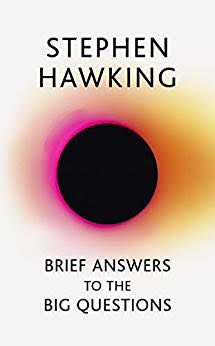Author: Stephen Hawking
Genre: Science

Like the rest of the world, I remain a big fan of Hawking. What made Stephen Hawking so popular? First, as Nobel Laureate Kip Thorne says in the foreword to this book, Hawking had the “necessary skills, wisdom and self-confidence” to ask some really big questions. And “Hawking’s questions themselves keep on… generating breakthroughs decades later.” At a more personal level, his daughter, Lucy Hawking, says of his contribution: “Both in… exploring the structure and origins of the universe itself and (on the other hand) in his completely human bravery and humour in the face of his challenges. He found a way to reach beyond the limits of knowledge while surpassing the limits of endurance at the same time. I believe it was this combination which made him so iconic yet so reachable, so accessible.”
So, it is only natural that when such a man writes his last work, compiled in the last year of his life, we should all devour it with the same curiosity that made him great. In this book, Stephen gives his take on 10 really big questions in life.
First, Is there a God? After admitting that “religion was an early attempt to answer the questions we all ask: why are we here, where did we come from?”, he confirms that “the universe is a machine governed by principles or laws” and even “God would have no freedom at all” to break them. To create universe, you need energy and space, and when you look at the “vast size of the universe, and how insignificant and accidental human life is in it, (the concept of a human like God) seems most implausible”. He sums up saying “that the simplest explanation is that there is no God.”

Then, Is there other Intelligent Life in the Universe? He explains that a living being has two essential elements: a set of instructions that tell the system how to keep going and reproduce; and a mechanism to carry out those instructions. [He even suggests that computer viruses should count as life!]. And given billions of years of evolution on earth under favourable circumstances, “random collisions between atoms built up macromolecules that could reproduce themselves and assemble themselves into more complicated structures.” Thus, RNA and then DNA molecule was simply made by chance and then grew into higher beings on our planet. Now given there are “billions of galaxies” and “each containing billions of stars”, and many of these stars have planets around them, and certainly some planets in the elusive Goldilock zone (just the right distance from the star to make organic life possible), there most certainly ought to be life elsewhere, evolved using the same low probability as it happened on earth. Then why haven’t we been visited? Stephen believes “that there are other forms of intelligent life out there, but that we have been overlooked.” Distances in universe are so great that even by using our fastest technology of today, it will take us 70,000 years to visit the nearest star, and yet we will still be in our own corner of our own galaxy. And Hawking’s warns that even if we do hear some extra terristial message, we should not answer back till have developed a bit further. “Meeting a more advanced civilisation, at our present stage, might be a bit like the original inhabitants of America meeting Columbus” and we would most likely end up being colonised.

Can we predict the Future? Hawking starts by quoting Laplace, “If at one point we knew the positions and speeds of all the particles in the universe, then we would be able to calculate their behaviour at any other time in the past or future… It implies that we can predict the future, in principle at least.”

What is inside a Black Hole? Hawking’s reputation as a stellar scientist was largely based on his path-breaking work on Black Holes. It was a pity that he could not get the Nobel Prize, since that requires proof and so far no one has been able to find proof of what his theory predicted. In his own words, “People have searched for mini black holes of this mass, but so far have not found any. This is a pity because, if they had, I would have got a Nobel Prize.” [By the way, Nobel Prizes cannot be awarded posthumously, so sadly this ambition will never be realised.] A very massive star whose escape velocity was greater than the speed of light would drag back by gravity any light they would emit. So, we would not be able to see it and hence the term black hole. They would also eventually keep compressing under their own gravity, up till a point called singularity, much like the conditions just before the Big Bang, where time and space would cease to exist. These would remain hidden from view inside a black hole. There is one large black hole, 4 million times the mass of Sun, right at the centre of our own milky way galaxy.

Is Time Travel Possible? “Rapid space travel and travel back in time can’t be ruled out according to our present understanding. They would cause great logical problems… but science fiction fans need not lose heart. We have experimental evidence from the bending of light that space-time is curved… and that we can warp it in the negative direction. So, it might seem that as we advance in science and technology we might be able to construct a wormhole or warp space and time in some other way so as to be able to travel into our past.”

There is also a solemn chapter on Will We Survive On Earth? Oppenheimer, the inventor of atom bomb, quoted from Gita, “Now I am become Death, the destroyer of worlds”. Hawking, ever the optimist, is still a pessimist on this count. “The earth is under threat from so many areas that it is difficult for me to be positive. The threats are too big and too numerous… Rising temperatures, reduction of the polar ice caps, deforestation, over population, disease, war, famine, lack of water and decimation of animal species; these are all solvable but so far have not been solved.
Which brings him to his favourite subject: Should we Colonise Space? Stephen is “convinced that humans need to leave Earth. If we stay, we risk being annihilated.” Hence he started Breakthrough Starshot, “a proof of concept mission that works on three concepts: miniaturised spacecraft, light propulsion and phase locked lasers. The Star Chip, a fully functional space probe reduced to a few centimetres in size, will be attached to a light sail… a thousand Star Chips and light sails, the nano craft, will be sent into orbit. On the ground, an array of lasers… would create a powerful light beam” that the nano craft would ride on. “Such a system would reach Pluto in days and Alpha Centauri (the nearest star) in just over twenty years.”
Why you should read this book: Hawking’s credits his success to being “brought up by my parents to have an unwavering curiosity” and hence spent his life “travelling across the universe, inside my mind.” Recall Einstein when asked the secret of his success also said, “I am not special, just passionately curious”. So, dear readers, read on to vet your own curiosity, not just to be wiser, but to become more human!
Goodreads Link: Brief Answers to the Big Questions by Stephen Hawking | Goodreads

 This information will never be shared with third party
This information will never be shared with third party